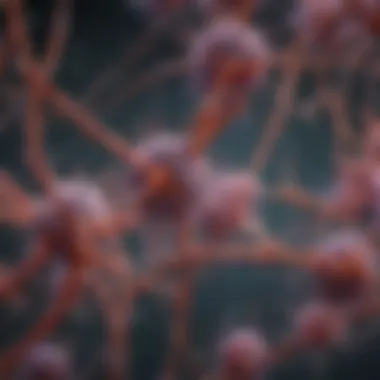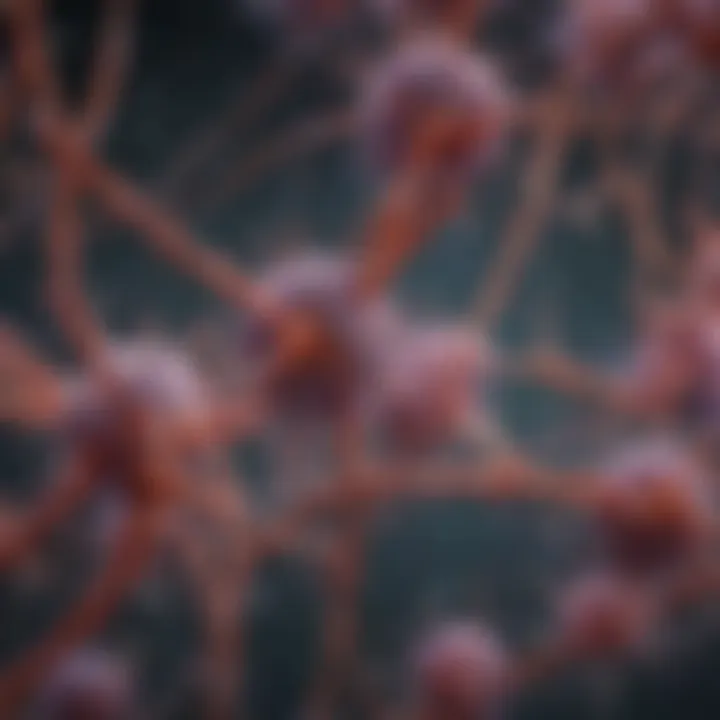Exploring the Pathology of Parkinson's Disease


Intro
Parkinson's disease is a complex neurological disorder characterized by a progressive decline in motor function and various non-motor symptoms. Understanding its pathology is critical for developing effective treatment strategies and enhancing patient care. The interplay between genetics and environmental factors plays a significant role in the disease's initiation and progression.
This article delves into the neurobiological mechanisms that underlie Parkinson's disease, emphasizing the significance of alpha-synuclein accumulation. By exploring recent advancements and established findings, we aim to provide an insightful overview of the pathology, ultimately serving as a guide for students, researchers, and professionals.
Research Overview
Summary of Key Findings
Research indicates several intrinsic and extrinsic factors contributing to the onset and progression of Parkinson's disease. Some of the key findings include:
- The aggregation of alpha-synuclein is central to the pathology.
- Genetic mutations, such as those in the LRRK2 or SNCA genes, significantly increase disease risk.
- Environmental toxins like pesticides may act as triggers.
- Neuroinflammation contributes to neuronal death and disease symptoms.
Background and Context
Parkinson's disease has been studied for many years. It's recognized that the loss of dopaminergic neurons in the substantia nigra leads to significant motor symptoms, such as tremors, rigidity, and bradykinesia. Non-motor symptoms, including depression, cognitive decline, and sleep disturbances, often complicate the clinical picture. Understanding these aspects is essential for comprehensive patient management.
Methodology
Experimental Design
Research into Parkinson's disease employs various experimental designs, including longitudinal studies, case-control studies, and animal models. These approaches allow researchers to observe the disease's progression and identify potential therapeutic targets.
Data Collection Techniques
Data is collected through various methods, such as clinical assessments, neuroimaging techniques, and biochemical assays. These methods enable the evaluation of both motor and non-motor symptoms, as well as the identification of biomarkers associated with the disease.
Understanding the underlying mechanisms of Parkinson's disease is crucial for paving the way for future treatments.
The complexities of Parkinson's disease pathology require ongoing research and collaboration across disciplines. Future studies should continue to focus on the interaction between genetic predispositions and environmental exposures, as well as the development of innovative therapeutic strategies.
Foreword to Parkinson's Disease
Parkinson's disease is a significant neurological disorder that impacts millions worldwide. Understanding this condition is vital not only for those directly affected but also for their families and the healthcare community at large. This section lays the groundwork for comprehensively exploring the intricacies of Parkinson's disease, from its definition to historical milestones. Delving into these facets allows for a deeper appreciation of the complexities associated with its pathology. Recognizing the importance of these insights can aid in both academic inquiry and practical applications.
Definition and Overview
Parkinson's disease is a progressive neurodegenerative disorder characterized by the gradual loss of dopaminergic neurons in the brain, particularly in the substantia nigra region. This leads to various motor and non-motor symptoms. The primary symptoms include tremors, rigidity, bradykinesia, and postural instability. Non-motor symptoms, such as sleep disturbances, depression, and cognitive decline, can also significantly affect the quality of life of individuals. The exact etiology remains unclear, but a combination of genetic predispositions and environmental factors likely contributes to its development.
Historical Context
The understanding of Parkinson’s disease has evolved significantly over time. The condition is named after James Parkinson, who first described it in 1817 in his essay titled "An Essay on the Shaking Palsy." However, evidence suggests that the symptoms of Parkinson's disease were recognized even before this publication. In ancient texts, references to similar symptoms can be found, indicating that this condition has existed for centuries. Over the years, research has progressed, shifting from purely observational accounts to modern neuroscientific studies that explore the underlying mechanisms of the disease. Advances in neuroimaging and molecular biology have provided new insights, allowing for a more nuanced understanding of Parkinson's pathology. Continuous research into both its historical and contemporary contexts is crucial for improving diagnosis and treatment options.
Neuroanatomy and Neurobiology
The exploration of neuroanatomy and neurobiology is essential to understanding Parkinson's disease. This area focuses on the brain's structure and function, elucidating how specific systems are affected by the disease. Parkinson's impacts the neural pathways responsible for movement and coordination. Understanding these processes helps to unravel the complexities inherent in the disease's progression. It also aids in recognizing how medical interventions can target specific biological mechanisms. To appreciate the clinical symptoms seen in Parkinson's disease, one must first grasp the underlying anatomy and biology of the affected brain regions.
Basal Ganglia Systems
Basal ganglia systems comprise a group of interconnected nuclei in the brain that play a crucial role in regulating motor control and movement. The primary structures involved include the striatum, globus pallidus, and substantia nigra. The basal ganglia facilitate voluntary movements and aid in the learning of motor tasks. They also process rewarding behaviors and emotions. In Parkinson's disease, the degeneration of dopaminergic neurons in the substantia nigra disrupts this intricate balance. The loss of dopamine leads to increased inhibitory output to the thalamus, which results in impaired motor function.
Key points to consider:
- Motor Control: The basal ganglia are integral in fine-tuning motor commands, ensuring smooth and controlled movements.
- Neural Circuits: Understanding the circuitry provides insight into therapy methods targeting these specific pathways.
- Clinical Correlations: Observations of tremors and rigidity relate directly to disruptions in the basal ganglia's operation.
Role of Dopaminergic Neurons
Dopaminergic neurons, particularly those in the substantia nigra, are vital in regulating movement and emotional responses. They contribute significantly to the brain's reward system. These neurons release dopamine, a neurotransmitter crucial for initiating and controlling movement. In Parkinson's disease, the progressive loss of these neurons leads to the characteristic motor symptoms. As dopamine levels decrease, patients experience rigidity, bradykinesia, and postural instability.


Prominent aspects include:
- Motor Impairments: Reduced dopamine underscores many of the motor symptoms associated with Parkinson's disease.
- Neurotransmitter Dynamics: Understanding dopamine signaling can guide the development of pharmacological treatments aimed at restoring balance.
- Behavioral Impact: The influence of dopamine stretches beyond movement, affecting mood and motivation. This underscores the need for a holistic view in treatment approches.
"The intricate relationship between neuronal health and motor function cannot be overstated in the context of Parkinson's disease."
In summary, the study of neuroanatomy and neurobiology, particularly the roles of basal ganglia systems and dopaminergic neurons, lends significant insight into Parkinson's disease pathophysiology. This understanding lays a foundation for advancing strategies aimed at alleviating symptoms and improving overall quality of life for those diagnosed with this challenging condition.
Pathophysiology of Parkinson's Disease
The pathophysiology of Parkinson's disease is essential for understanding how this condition develops and affects individuals. It encompasses the systematic changes in the brain and body that lead to the characteristic symptoms of the disease. Focusing on the cellular and molecular alterations provides insights into potential therapeutic targets and enhances our understanding of disease progression. By unraveling the intricate mechanisms involved, researchers can better appreciate the importance of early intervention and the need for tailored treatment strategies.
Alpha-Synuclein Aggregation
Alpha-synuclein is a protein that plays a critical role in synaptic function, but its aggregation is a hallmark of Parkinson's disease. In healthy neurons, alpha-synuclein helps with neurotransmitter release and synaptic plasticity. However, under pathological conditions, alpha-synuclein forms insoluble aggregates called Lewy bodies. These aggregates disrupt normal cellular function and contribute to neuronal toxicity. The accumulation often begins in the olfactory bulb and spreads through connected regions in the brain.
Research suggests that the misfolded alpha-synuclein can spread from one neuron to another, propagating the disease process. This prion-like behavior raises concerns about the interconnectedness of neuronal health. Prevention of alpha-synuclein aggregation might be a focus for new therapies, highlighting the need for ongoing research into this mechanism.
Neuroinflammation Factors
Neuroinflammation is another significant aspect of the pathophysiology of Parkinson's disease. Chronic inflammation in the brain is often characterized by the activation of microglia, the brain's resident immune cells. When activated, microglia release pro-inflammatory cytokines, which can further damage neurons. Persistent inflammation may not only exacerbate neuronal loss but also influence the course of the disease.
Several studies have shown that inflammatory markers are elevated in the cerebrospinal fluid of Parkinson's patients. This suggests that inflammation may play a role in early pathogenesis. Targeting neuroinflammation could provide new avenues for treatment. For example, medications that inhibit inflammatory pathways might serve as adjunct therapies for managing Parkinson's disease.
Oxidative Stress Mechanisms
Oxidative stress refers to the imbalance between reactive oxygen species (ROS) production and the body's ability to detoxify these harmful compounds. In Parkinson's disease, the dopaminergic neurons are particularly vulnerable to oxidative stress. The degradation of dopamine metabolism produces ROS, further contributing to cellular damage.
Increased oxidative stress can lead to mitochondrial dysfunction, which is a significant feature of neurodegenerative diseases. Mitochondrial impairment prevents cells from effectively producing ATP, essential for energy supply. Furthermore, oxidative damage can induce protein misfolding, including alpha-synuclein. This connection reinforces the cycle of neuronal degeneration. Exploring antioxidant therapies represents a promising approach in research aimed at mitigating the effects of oxidative damage.
Understanding the pathophysiology of Parkinson's disease is crucial for shaping effective treatment approaches. By addressing protein aggregation, neuroinflammation, and oxidative stress, we can pave the way for innovative therapies to manage this complex disorder.
Clinical Manifestations
Clinical manifestations are crucial in understanding Parkinson's disease. This section covers the various symptoms that present in patients and how these symptoms help in diagnosing and managing the disease. Recognizing these manifestations can guide treatment options and improve patients' quality of life.
Motor Symptoms
Motor symptoms in Parkinson's disease primarily arise from the degeneration of dopaminergic neurons in the basal ganglia. These typically include:
- Tremor: This is often the most recognizable symptom. It usually begins in one hand and may be present at rest.
- Bradykinesia: Patients experience a reduction in voluntary movements, leading to slowness in physical activities. It can significantly impact daily tasks.
- Rigidity: Muscle stiffness can occur, making movements difficult and painful. This symptom can also affect posture.
- Postural Instability: Patients often find it hard to maintain balance, which can lead to falls. This symptom can progress over time, increasing the risk of injuries.
These motor symptoms arise gradually, and their progression can vary widely among individuals. Understanding these symptoms is essential for implementing strategies that can help manage them effectively.
Non-Motor Symptoms
Non-motor symptoms often receive less attention but are equally important in the context of Parkinson's disease. They significantly affect patients' overall well-being. Common non-motor symptoms include:
- Depression: This can impact many individuals with Parkinson's, contributing to a decreased quality of life.
- Anxiety: Patients may experience heightened anxiety, which can complicate treatment and daily activities.
- Cognitive Changes: Some individuals develop cognitive impairments or dementia over time, affecting memory and thinking.
- Sleep Disturbances: Trouble sleeping is common and can exacerbate fatigue and other symptoms.
- Autonomic Dysfunction: This can include issues such as constipation, bladder problems, and blood pressure irregularities.
Understanding both motor and non-motor symptoms is critical for a holistic approach in managing Parkinson's disease. By addressing the full spectrum of clinical manifestations, healthcare providers can tailor treatment plans that enhance patient outcomes.
"Effective management of Parkinson's disease symptoms requires comprehensive care that addresses both motor and non-motor aspects of the disease."
This section lays the groundwork for the subsequent discussions on diagnosis and treatment approaches, emphasizing the multifaceted nature of Parkinson's disease.
Diagnosis of Parkinson's Disease
Diagnosis of Parkinson's disease is crucial in understanding the progression and management of this debilitating condition. Early and accurate diagnosis enables timely interventions, improving the quality of life for patients. This section outlines the diagnostic criteria and imaging techniques critical in identifying Parkinson's disease.
Diagnostic Criteria


The diagnostic criteria for Parkinson's disease primarily rely on clinical evaluation. Physicians assess the presence of motor symptoms such as bradykinesia, resting tremor, and rigidity. According to the UK Parkinson's Disease Society Brain Bank criteria, a diagnosis requires the following:
- Bradykinesia: Slowness of movement is fundamental. Acquiring this symptom is essential for the diagnosis.
- Resting Tremor: Tremors typically occur while the patient is at rest and often affect the hands or feet.
- Rigidity: Stiffness in the limbs signifies neuromuscular dysfunction.
Other considerations include the duration and progression of symptoms. The presence of non-motor symptoms, such as sleep disturbances and cognitive changes, can also aid in refining the diagnosis.
Imaging Techniques
While clinical assessment is predominant, imaging techniques can support the diagnosis. Some beneficial methods include:
- MRI (Magnetic Resonance Imaging): MRI helps exclude other conditions that mimic Parkinson's disease symptoms. Structural changes in the brain can provide indirect evidence of the disease.
- DAT Scan: This specific imaging technique visualizes dopamine transporter levels in the brain, allowing a deeper view into the degeneration of dopaminergic neurons.
- PET (Positron Emission Tomography): PET scans can provide metabolic information about brain function, showing areas affected by Parkinson's disease.
"Imaging supports the clinical diagnosis, but no singular test confirms Parkinson's disease."
These imaging techniques not only assist in diagnosis but also help in monitoring disease progression over time, laying the foundation for tailored therapeutic strategies. By understanding these diagnostic elements, healthcare professionals can enhance their approach to patient care, thus addressing the multifaceted challenges presented by Parkinson's disease.
Etiological Factors
Understanding the etiology of Parkinson's disease is crucial for several reasons. First, identifying the causes can aid in the development of prevention strategies. Second, it can lead to more effective treatments by targeting specific pathways involved in the disease process. Lastly, examining both genetic and environmental contributions allows for a holistic view, which is essential for comprehensive understanding and management.
Genetic Contributions
Genetic factors play a pivotal role in the pathology of Parkinson's disease. Certain genetic mutations are strongly associated with familial forms of the disease. For instance, mutations in the SNCA gene contribute to the overproduction of alpha-synuclein, which is vital for understanding the aggregation of this protein in the brains of affected individuals.
Additionally, there are mutations in the LRRK2 gene, which are one of the most common genetic variants linked to autosomal dominant Parkinson's disease. Understanding these genetic underpinnings provides insight into mechanisms of neurodegeneration, potentially guiding therapeutic interventions.
However, it is important to note that the genetic contributions represent only a fraction of the cases. Most individuals diagnosed with Parkinson's disease do not have a direct hereditary link. This indicates that genetic predisposition is not the only factor at play.
Environmental Influences
Environmental factors also significantly impact the risk of developing Parkinson's disease. Exposure to certain toxins, such as pesticides like paraquat, has been linked to increased incidences of the disease. Occupational exposure in farming and other related fields appears to have a correlation with the onset of symptoms.
Additionally, head injuries have been studied for their potential link to developing Parkinson's disease later in life. Notably, the presence of certain oxidative stressors in the environment may enhance neuronal vulnerability, thus exacerbating genetic predispositions.
The interplay between these environmental aspects and genetic makeup creates a complex network of risk factors that makes Parkinson's disease's etiology multifaceted. Recognizing this complexity is vital for formulating strategies for both prevention and intervention.
Therapeutic Approaches
Therapeutic approaches in Parkinson's disease are crucial for managing symptoms and improving quality of life. As the disease progresses, individuals experience a range of symptoms that impact daily functioning. Hence, it is essential to explore both pharmacological and non-pharmacological methods to address these challenges effectively.
Pharmacological Treatments
Pharmacological treatments remain the cornerstone of Parkinson's disease management. These treatments aim to alleviate motor and non-motor symptoms through various mechanisms. The most commonly prescribed medication is Levodopa, which is converted into dopamine in the brain, helping to replenish the deficit caused by neuron degeneration. Additionally, Dopamine agonists like pramipexole and ropinirole stimulate dopamine receptors directly, providing another avenue for symptom control.
However, long-term use of these medications can lead to motor fluctuations and side effects, necessitating a careful balancing act in treatment plans. The potential emergence of dyskinesia—involuntary movements resulting from prolonged dopamine therapy—underscores the need for ongoing assessment and possibly adjusting therapy.
"The choice of pharmacological agents must be personalized, considering patient-specific factors such as age, disease stage, and overall health".
Other treatments include MAO-B inhibitors (e.g., selegiline) and COMT inhibitors (e.g., entacapone), which help prolong the effects of Levodopa by reducing its breakdown. Each of these agents has its own efficacy profile and side effect potential, which must be weighed during the treatment planning process.
Non-Pharmacological Interventions
Non-pharmacological interventions have gained recognition as essential components of comprehensive care for Parkinson's disease. These approaches aim to improve quality of life by enhancing physical function, emotional health, and social engagement. Physical therapy can help to maintain mobility and prevent falls, while occupational therapy aids in adapting activities of daily living to promote independence.
Speech therapy is also beneficial for those experiencing voice and communication challenges. Customized exercises can strengthen vocal cords, improving speech clarity and understanding.
In addition to traditional therapies, there is increasing interest in mindfulness and cognitive behavioral therapy, which target psychological well-being. These strategies can help patients cope with anxiety and depression, both of which are commonly associated with chronic illness.
Moreover, engaging in regular exercise has shown promising results. Aerobic activities and strength training can potentially slow the progression of motor symptoms, promoting stronger muscles and better coordination. Not only does addressing physical needs matter, but focusing on emotional and mental health too is vital for a holistic treatment approach.
Recent Research Developments


Recent research developments in Parkinson's disease provide a crucial window into advancements aimed at understanding and alleviating this complex condition. The dynamic nature of this research reflects a growing recognition of the multifaceted aspects of the disease, encompassing its biological mechanisms, potential therapeutic strategies, and the impact of both genes and environment on its progression. Understanding these developments helps not only in shaping future research directions but also in enhancing current treatment protocols.
Vaccine Approaches
Vaccine approaches for Parkinson's disease target the underlying pathological processes, especially the aggregation of alpha-synuclein, a hallmark of the disease. Recent studies explore methods of inducing an immune response against this misfolded protein, which could potentially slow down or halt disease progression. The rationale behind these vaccine strategies is based on the observation that the immune system can recognize and clear abnormal protein aggregates.
These vaccine candidates can be classified into two broad categories:
- Active vaccination: This involves introducing an antigen to elicit an immune response that targets alpha-synuclein.
- Passive vaccination: Here, pre-formed antibodies are administered to neutralize the toxic effects of alpha-synuclein aggregates.
Ongoing clinical trials are critical in assessing the safety and efficacy of these vaccine approaches. One such trial, being conducted by the pharmaceutical company AC Immune, uses a vaccine to trigger an immune response specifically against alpha-synuclein. Preliminary findings suggest that not only is it well-tolerated, but it may also lead to a reduction in alpha-synuclein levels in cerebrospinal fluid, indicating potential for further development.
Gene Therapy Innovations
Gene therapy represents a revolutionary area of research in the management of Parkinson's disease. By directly targeting the genes implicated in the condition, researchers aim to correct or modify genetic malfunctions that contribute to neuronal degradation. The focus is largely on delivering therapeutic genes that can enhance the production of neuroprotective factors or inhibit the production of harmful proteins like alpha-synuclein.
Among the leading methods in this field are:
- Adeno-associated virus vectors (AAV): These are commonly used to deliver therapeutic genes to the brain with minimal immune response.
- CRISPR technology: This allows for precise editing of the genome, potentially correcting mutations responsible for the disease.
Promising research led by scientists at the University of California, San Francisco, is evaluating the ability of gene therapy to deliver neurotrophic factors that can help to protect and regenerate dopaminergic neurons. Initial animal studies show rescue effects in neuronal survival and function. These findings lay the groundwork for future phase I clinical trials, targeting both safety and efficacy in humans.
"The rapid evolution of vaccine approaches and gene therapy innovations marks a paradigm shift in how we can potentially treat Parkinson's disease, moving beyond conventional therapies to target the very mechanisms of disease progression."
In summary, recent developments in the fields of vaccine approaches and gene therapy are at the forefront of Parkinson's disease research. These innovations may not only enhance our understanding of the pathology but also open up new avenues for treatment, providing hope for better management strategies in the future.
Future Directions in Parkinson's Research
Exploring future directions in Parkinson's research is crucial. As our understanding of the disease evolves, it is essential to identify innovative strategies that could enhance treatment and improve patient outcomes. By focusing on the latest advancements in research, we can better grasp the multifaceted nature of Parkinson's disease. This section highlights key areas that promise significant insights and breakthroughs in managing this complex neurodegenerative disorder.
Emerging Therapeutic Strategies
In recent years, therapeutic strategies targeting the unique pathophysiology of Parkinson's disease have emerged. Innovative approaches include:
- Protein clearance methods: Research is directed toward enhancing pathways that eliminate misfolded proteins, particularly alpha-synuclein.
- Stem cell therapies: This area investigates the potential of stem cells to regenerate dopaminergic neurons lost to the disease. Initial trials show promise, but more long-term studies are necessary.
- Neuroprotective agents: Developing drugs that offer protection to brain cells is essential. For instance, compounds that target oxidative stress may help prevent neuronal death.
Additionally, modifying existing therapies to improve their efficacy is important. For example, optimizing the delivery of levodopa could enhance its effectiveness and potentially delay the onset of motor complications.
Personalized Medicine Perspectives
The concept of personalized medicine is gaining traction in Parkinson's research. This approach tailors treatment to the individual, taking into account their unique genetic, environmental, and lifestyle factors. Key advantages include:
- Genetic profiling: By understanding a patient's genetic makeup, clinicians can better predict the disease's progression and tailor therapies accordingly.
- Targeted therapies: Instead of a one-size-fits-all treatment, targeted therapies could lead to more effective management of symptoms and reduce side effects.
- Patient engagement: Involving patients in their treatment plans may lead to improved adherence and satisfaction.
Overall, advancements in personalized medicine hold the potential to redefine how Parkinson's disease is managed. This requires multidisciplinary collaboration among researchers, healthcare providers, and patients to fully realize its benefits.
"Emerging strategies and personalized approaches could revolutionize Parkinson's disease treatment, improving the quality of life for millions."
Closure
In the context of this article, the conclusion serves to encapsulate the critical insights gathered regarding Parkinson's disease. It highlights the multifaceted nature of this neurodegenerative disorder, emphasizing that understanding its pathology is paramount for effective treatment and management. This understanding is not just academic; it has real-world implications for those affected by the disease.
Summary of Findings
Throughout the article, several key findings emerge that delineate the complex mechanisms underpinning Parkinson's disease. The following points are significant:
- Alpha-Synuclein's Role: The accumulation of alpha-synuclein presents a central feature of Parkinson's pathology. This protein forms aggregates that are toxic to neuronal cells, contributing to the progression of the disease.
- Neuroinflammatory Responses: Inflammation plays a pivotal role in the disease's etiology. Various studies indicate that neuroinflammation may exacerbate neuronal degeneration, linking environmental factors to cellular stress responses.
- Oxidative Stress: The imbalance between oxidative species and the body's antioxidant defenses contributes to neuronal death and is a significant factor in the course of the disease. Understanding these mechanisms opens pathways for potential therapeutic interventions.
- Clinical Manifestations: Both motor and non-motor symptoms present unique challenges in diagnosis and treatment, highlighting the need for comprehensive care strategies.
- Diagnostic Advances: Evolving imaging techniques and criteria for diagnosis demonstrate improvement in identifying the disease earlier and more accurately.
These insights collectively underscore the complexity of Parkinson's disease, setting the stage for future inquiry and innovation in treatment methodologies.
Implications for Practice
The findings presented in this article carry substantial implications for practice in several ways. They suggest that:
- Targeted Therapeutics: Future therapeutic strategies should consider interventions that directly address alpha-synuclein aggregation and neuroinflammatory processes. There is a need for a more precise targeting of these processes to slow down the disease's progression.
- Holistic Care Models: The diverse symptomatology—ranging from motor impairments to cognitive dysfunction—indicates that a multidisciplinary approach is essential. Care models need to be adaptable, focusing on individualized patient needs.
- Ongoing Education: Continuous professional development for healthcare practitioners about emerging research and treatment paradigms is necessary. Staying updated helps enhance patient outcomes significantly.
- Research Collaboration: There is a pressing need for collaboration among researchers, clinicians, and industry stakeholders. Such partnerships can drive innovation and expedite the discovery of groundbreaking therapies.
In summary, the conclusion of this article offers not only a reflection on the discussed material but also emphasizes the urgent need for sustained research efforts and improved patient care strategies in the arena of Parkinson's disease.







